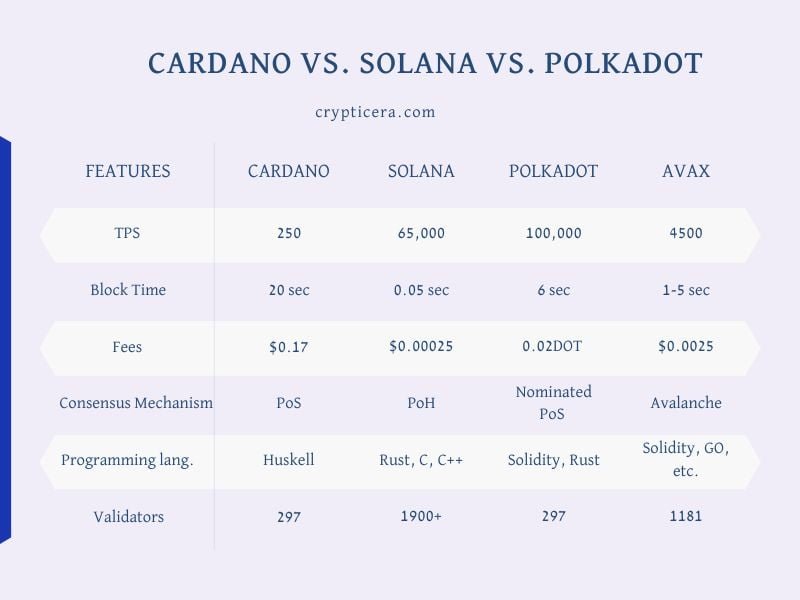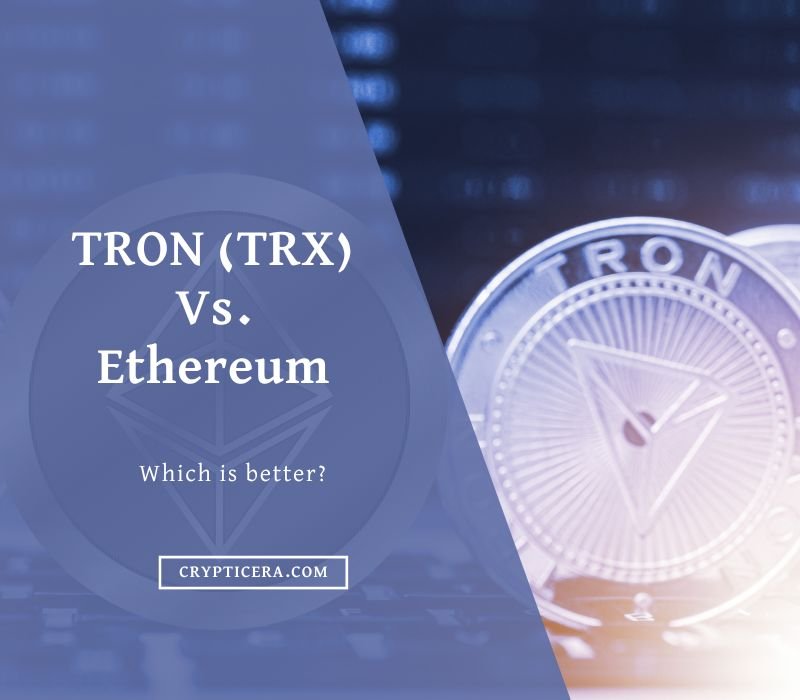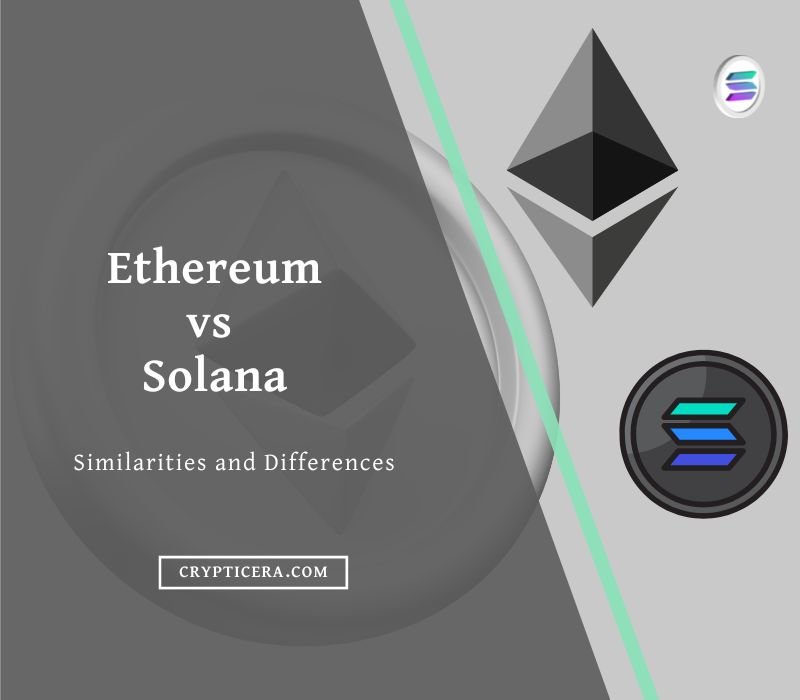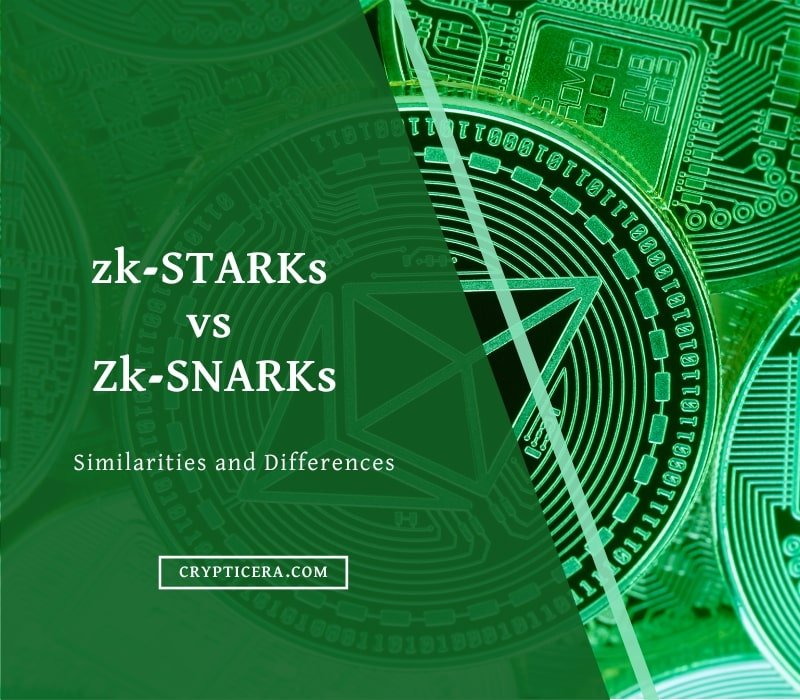In the world of blockchain technology, there are many different platforms that are vying for the top spot. Three of the most popular and highly-regarded platforms are Cardano, Solana, and Polkadot.
Each of these platforms has its own unique features and capabilities, and they are all well-suited to different types of use cases.
In this blog post, we will take a closer look at these three platforms and compare and contrast their strengths and weaknesses. We will explore how each platform is being used in the real world, and take a look at what the future holds for each of these blockchain platforms.
So, we will provide an in-depth analysis of Cardano vs Polkadot vs Solana.
Cardano vs Polkadot vs Solana: At a Glance
| Feature | Cardano | Polkadot | Solana |
|---|---|---|---|
| Consensus mechanism | Proof-of-Stake | Nominated PoS | Proof-of-History |
| Transaction speed | 250 Tps | 100-1000 TPS | 65,000 TPS |
| Smart Contract language | Yes | Yes | Yes |
| DApps | Yes | No | Yes |
| Scalability | low | Medium | High |
| Market capitalization | $12.18 billion | $6.9 billion | $8.5 billion |
Note: TPS stands for transactions per second. The market capitalization values are based on the current market prices of the cryptocurrencies and are subject to change.
Cardano vs Polkadot vs Solana: The Ultimate Comparison

Scalability
Cardano’s use of a “layered” architecture allows for different parts of the network to be upgraded and optimized independently, further increasing its overall scalability.
Polkadot, on the other hand, uses a unique “parachain” architecture that allows multiple blockchains to be connected and operate together as a single, scalable network.
This allows for faster transaction processing and greater overall throughput than other blockchain platforms.
Solana takes a different approach to scalability. It uses a mechanism called “Proof of History” to create a verifiable record of events that allows the network to process transactions very quickly.
Solana claims to be able to process over 65,000 transactions per second, making it one of the fastest blockchain platforms currently in existence.
Transaction Speed
Transaction speeds for Cardano, Polkadot, and Solana vary depending on the number of validators and the amount of network congestion.
ADA: The average transaction speed on the Cardano network is around 250 seconds per transaction.
DOT: The average transaction speed on the Polkadot network is around 1000-100,000 TPS. (Please note: Practically, the transaction speed of polkadot is between 100-1000 tps)
SOL: Solana has been known for its high transaction speed, currently it can process up to 65,000 transactions per second.
Keep in mind that these numbers are approximate and subject to change as the networks evolve and scale.
Transaction Fees
Transaction fees on Cardano are determined by the amount of computational work (measured in “ADA” units) required to process a transaction.
The more complex the transaction, the higher the fee. The average transaction fee on Cardano is currently around 0.17 ADA.
The average transaction fee on Polkadot is currently around 0.0005 dot. The more complex the transaction, the higher the fee.
Solana is the cheapest network among all three networks with a transaction throughput of 0.00001 sol.
Smart Contract Language
Smart contracts on Cardano are written in the Plutus programming language, which is based on “Haskell”.
Plutus is a strongly typed, functional programming language that is designed to be secure and easy to reason about.
Smart contracts on Polkadot can be written in a variety of languages, including Solidity, Rust, C++, and JavaScript.
The official Polkadot development platform, Substrate, provides a framework for building smart contracts in EVM Solidity.
Solana’s smart contract language is” Rust“.
Rust is a programming language known for its performance and security, making it a suitable choice for building smart contracts on the Solana blockchain.
ADA vs DOT vs SOL: Token Economics
ADA is the native token of the Cardano blockchain, DOT is the native token of the Polkadot blockchain, and SOL is the native token of the Solana blockchain.
Cardano uses a proof-of-stake consensus mechanism called Ouroboros, in which token holders can stake their ADA to participate in the validation of new blocks and earn a reward.
The total supply of ADA is fixed at 45 billion, with a current circulating supply of around 34.5 billion.
Polkadot uses a unique multi-chain architecture that allows for interoperability between different blockchain networks. DOT is used for governance and staking, allowing token holders to participate in network upgrades and earn a reward.
The total supply of DOT is 1.15 billion. 100% of its supply is in circulation.
The total supply of SOL is fixed at 370.7 million, with a current circulating supply of around 370 million.
What is Cardano (ADA)?

Cardano is a blockchain platform that aims to be a “next-generation” Ethereum, offering a more secure and sustainable ecosystem for the development and execution of smart contracts and decentralized applications.
It utilizes a unique consensus algorithm called “Proof of Stake” which is designed to be more energy efficient and improve scalability.
The project is built on a strong foundation of academic research and is constantly evolving to meet the needs of its users and the ever-changing crypto landscape.
Blockchain URL: Cardano
Key Features of Cardano
- Cardano has a layered architecture, which separates the settlement layer (where transactions are processed) from the computation layer (where smart contracts are executed).
- It is a proof-of-stake (PoS) blockchain that provides an energy-efficient and secure consensus mechanism.
- Cardano blockchain utilizes a new programming language, called Plutus, which makes it easier for developers to build applications on the blockchain.
- The blockchain is built on a scientific philosophy and uses peer-reviewed research to ensure that the protocols and algorithms are secure and reliable.
- Cardano blockchain has a native cryptocurrency, ADA, which is used to fuel transactions and secures the network.
Pros and Cons of Cardano
| Pros | Cons |
|---|---|
| High security & stability | Slow transaction speeds |
| Developed by experts in cryptography | Not widely adopted |
| Unique proof-of-stake algorithm | Limited use cases |
| Strong community & active development | High volatility |
| Focus on sustainability & scalability |
What is Polkadot (DOT)?

Polkadot is a blockchain platform that allows multiple blockchains to interoperate with each other.
It is designed to be a more scalable and flexible alternative to other blockchain platforms, such as Ethereum.
Polkadot was created by the Web3 Foundation, with the goal of creating a decentralized web that is more open and accessible to all.
The platform uses a novel consensus mechanism called “proof of stake” (PoS).
The native cryptocurrency of the Polkadot platform is called DOT.
Key features of Polkadot (DOT)?
Here are some key features of the Polkadot platform:
- Interoperability: Polkadot allows different blockchain networks to communicate and transfer data with each other, enabling a more seamless and interconnected ecosystem.
- Scalability: The platform uses a unique scalability mechanism called “parachains,” which allows multiple blockchains to operate in parallel and process transactions simultaneously. This allows for higher transaction throughput and faster confirmation times.
- Flexibility: Polkadot is designed to be a highly modular platform, with support for a wide range of different applications and use cases. It allows developers to build custom blockchain networks that can interact with the larger Polkadot ecosystem.
- Security: The network uses a proof of stake consensus mechanism, which is intended to be more secure and energy-efficient than proof of work. In addition, Polkadot has built-in mechanisms for identifying and penalizing malicious actors on the network.
- Governance: Polkadot has a decentralized governance system that allows token holders to vote on key decisions and changes to the network. This allows the community to have a say in the direction and development of the platform.
Pros and Cons of Polkadot
| Pros | Cons |
|---|---|
| Scalability | Lack of adoption and development |
| Interoperability | High volatility and risk |
| Flexibility and modularity | Complexity and steep learning curve |
| High potential for growth | Dependence on future developments and updates |
| Lower barriers to entry for new projects |
What is Solana (SOL)?

Solana (SOL) is a cryptocurrency that is designed to be fast, scalable, and secure. It is built on the Solana blockchain, which uses a proof-of-stake consensus mechanism and can process tens of thousands of transactions per second.
Solana has a number of features that make it unique, including low transaction fees and the ability to support decentralized applications.
It is an open-source project and has a growing community of users and developers.
Key features of Solana Blockchain
- Solana is a decentralized, open-source blockchain
- It has high scalability and can process thousands of transactions per second
- It has low transaction fees through a proof-of-history consensus mechanism
- Solana supports decentralized applications and has an active, open-source developer community
- It uses cryptographic techniques for network security and user asset protection
Pros and Cons of Solana
| Pros | Cons |
|---|---|
| High scalability | Lack of widespread adoption |
| Low transaction fees | Complexity |
| Decentralized applications | Limited availability of services and tools |
| Open-source | |
| Smart contract support |
Conclusion
In conclusion, Cardano, Solana, and Polkadot are all leading players in the blockchain space, each offering unique features and advantages.
Ultimately, the best choice for you will depend on your specific use case and priorities.
Whether you’re a developer looking to build decentralized applications, an investor looking to diversify your portfolio, or a business looking to integrate blockchain technology, one of these platforms is sure to meet your needs.
FAQs
What are the benefits of Solana, Polkadot, and Cardano?
Solana offers fast transaction speeds and low fees, Polkadot enables interoperability between different blockchains and also offers fast transaction speeds, and Cardano focuses on scalability and sustainability.
What are the potential limitations of Solana, Polkadot, and Cardano?
Solana, Polkadot, and Cardano are all relatively new and untested platforms, so they may have unknown vulnerabilities or other risks. In addition, the adoption of any blockchain platform depends on the willingness of users and developers to support it, and the success of any platform is never guaranteed.


